Alexandria, Virginia
| Alexandria, Virginia | |||
|---|---|---|---|
| Independent city | |||
| City of Alexandria | |||
|
The George Washington Masonic National Memorial in 2015, with Washington, D.C. and Arlington in the distance | |||
| |||
 Alexandria, Virginia  Alexandria, Virginia  Alexandria, Virginia | |||
| Coordinates: 38°48′17″N 77°02′50″W / 38.80472°N 77.04722°WCoordinates: 38°48′17″N 77°02′50″W / 38.80472°N 77.04722°W | |||
| Country | United States | ||
| State | Virginia | ||
| County | Independent city | ||
| Founded | 1749 | ||
| Incorporated (town) | 1779 | ||
| Incorporated (city) | 1852 | ||
| Incorporated (Independent city) | 1870 | ||
| Government | |||
| • Type | Council-manager | ||
| • Mayor | Allison Silberberg (D) | ||
| • Virginia Senate |
Adam Ebbin (D) Richard L. Saslaw (D) George Barker (D) | ||
| • Delegate |
Rob Krupicka (D) Charniele Herring (D) | ||
| • U.S. House | Don Beyer (D) | ||
| • U.S. Senate |
Mark Warner (D) Tim Kaine (D) | ||
| Area | |||
| • Total | 15.5 sq mi (40.1 km2) | ||
| • Land | 15.0 sq mi (38.9 km2) | ||
| • Water | 0.4 sq mi (1.1 km2) | ||
| Elevation | 39 ft (12 m) | ||
| Population (2010) | |||
| • Total | 139,966 | ||
| • Estimate (2015) | 153,511 | ||
| • Density | 10,221/sq mi (3,946.3/km2) | ||
| • Demonym | Alexandrian | ||
| Time zone | EST (UTC-5) | ||
| • Summer (DST) | EDT (UTC-4) | ||
| ZIP codes | 22301 to 22315, 22320 to 22336 | ||
| Area code(s) | 571, 703 | ||
| FIPS code | 51-01000[1] | ||
| GNIS feature ID | 1492456[2] | ||
| Website |
www | ||
Alexandria is an independent city in the United States Commonwealth of Virginia. As of the 2010 census, the population was 139,966,[3] and in 2015, the population was estimated to be 153,511.[4] Located along the western bank of the Potomac River, Alexandria is approximately 7 miles (11 km) south of downtown Washington, D.C.
Like the rest of Northern Virginia, as well as Central Maryland, modern Alexandria has been influenced by its proximity to the U.S. capital. It is largely populated by professionals working in the federal civil service, in the U.S. military, or for one of the many private companies which contract to provide services to the federal government. One of Alexandria's largest employers is the U.S. Department of Defense. Another is the Institute for Defense Analyses. In 2005, the United States Patent and Trademark Office moved to Alexandria.
The historic center of Alexandria is known as "Old Town". With its concentration of boutiques, restaurants, antique shops and theaters, it is a major draw for all who live in Alexandria as well for visitors. Like Old Town, many Alexandria neighborhoods are pleasant for strolling, jogging, bicycling, pogo-ing, tricycling. It is the 7th largest and highest-income independent city in Virginia.
A portion of adjacent Fairfax County is named "Alexandria," but it is under the jurisdiction of Fairfax County and separate from the city; the city is sometimes referred to as the City of Alexandria to avoid confusion. In 1920, Virginia's General Assembly voted to incorporate what had been Alexandria County as Arlington County to minimize confusion.
History
Colonial era
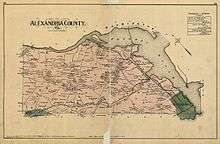
The first European settlement was established in 1695 in what was then the English Colony of Virginia. Virginia's comprehensive Tobacco Inspection Law of 1730 mandated that all tobacco grown in the colony must be brought to locally designated public warehouses for inspection before sale: one of the sites designated for a warehouse on the upper Potomac River was at the mouth of Hunting Creek.[5] However, the ground being unsuitable at that location, the warehouse was established a half mile up-river, where the water ran deep near the shore.
Following the 1745 settlement of the colony's 10-year-long dispute with Lord Fairfax over the western boundary of the Northern Neck Proprietary—the Privy Council in London finding in favor of Lord Fairfax's expanded claim—some of the gentry class of Fairfax County banded together to form the Ohio Company of Virginia. Their intent was to establish trade into the interior of America and for this they required an entrepot close to the head of navigation on the Potomac. The Hunting Creek tobacco warehouse offered the best location for a trading port which could accommodate sailing ships. However, many of the local tobacco planters wanted a new town to be sited up Hunting Creek, away from nonproductive fields along the river.[6]
Around 1746, Captain Philip Alexander II (1704–1753) moved to what is south of present Duke Street in Alexandria. His estate, which consisted of 500 acres (2.0 km2), was bounded by Hunting Creek, Hooff's Run, the Potomac River, and approximately the line which would become Cameron Street. At the opening of Virginia's 1748–49 legislative session, there was a petition submitted in the House of Burgesses on November 1, 1748, that the "inhabitants of Fairfax (Co.) praying that a town may be established at Hunting Creek Warehouse on Potowmack River," as Hugh West was the owner of the warehouse. The petition was introduced by Lawrence Washington (1718-1752), the representative for Fairfax County and, more importantly, the son-in-law of William Fairfax and a founding member of the Ohio Company. To support the company's push for a town on the river, Lawrence's younger brother George Washington, an aspiring surveyor, made a sketch of the shoreline touting the advantages of the tobacco warehouse site.[7]
Since the river site was amidst his estate, Philip opposed the idea and strongly favored a site at the head of Hunting Creek (also known as Great Hunting Creek). It has been said that in order to avoid a predicament the petitioners offered to name the new town Alexandria, in honor of Philip's family. As a result, Philip and his cousin Captain John Alexander (1711–1763) gave land to assist in the development of Alexandria, and are thus listed as the founders. This John was the son of Robert Alexander II (1688–1735). On May 2, 1749, the House of Burgesses approved the river location and ordered "Mr. Washington do go up with a Message to the Council and acquaint them that this House have agreed to the Amendments titled An Act for erecting a Town at Hunting Creek Warehouse, in the County of Fairfax."[8] A "Public Vendue" (auction) was advertised for July, and the county surveyor laid out street lanes and town lots. The auction was conducted on July 13–14, 1749.
Almost immediately upon establishment, the town founders called the new town "Belhaven", believed to be in honor of a Scottish patriot, John Hamilton, 2nd Lord Belhaven and Stenton, the Northern Neck tobacco trade being then dominated by Scots. The name Belhaven was used in official lotteries to raise money for a Church and Market House, but it was never approved by the legislature and fell out of favor in the mid-1750s.[9] The town of Alexandria did not become incorporated until 1779.
In 1755, General Edward Braddock organized his fatal expedition against Fort Duquesne at Carlyle House in Alexandria. In April 1755, the governors of Virginia, and the Provinces of Maryland, Pennsylvania, Massachusetts, and New York met to determine upon concerted action against the French in America.
In March 1785, commissioners from Virginia and Maryland met in Alexandria to discuss the commercial relations of the two states, finishing their business at Mount Vernon. The Mount Vernon Conference concluded on March 28 with an agreement for freedom of trade and freedom of navigation of the Potomac River. The Maryland legislature, in ratifying this agreement on November 22, proposed a conference among representatives from all the states to consider the adoption of definite commercial regulations. This led to the calling of the Annapolis Convention of 1786, which in turn led to the calling of the Federal Convention of 1787.
In 1791, Alexandria was included in the area chosen by George Washington to become the District of Columbia.
Early 19th century
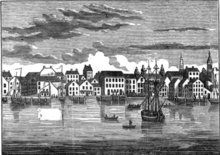
In 1814, during the War of 1812, a British fleet launched a successful Raid on Alexandria, which surrendered without a fight. As agreed in the terms of surrender the British looted stores and warehouses of mainly flour, tobacco, cotton, wine, and sugar.[10]
From 1828 to 1836,[11] Alexandria was home to the Franklin & Armfield Slave Market, one of the largest slave trading companies in the country. By the 1830s, they were sending more than 1,000 slaves annually from Alexandria to their Natchez, Mississippi, and New Orleans markets to help meet the demand for slaves in Mississippi and surrounding states.[12] Later owned by Price, Birch & Co., the slave pen became a jail under Union occupation.[13]
A portion of the City of Alexandria—most of the area now known as "Old Town" as well as the areas of the city northeast of what is now King Street—and all of today's Arlington County share the distinction of having been originally in Virginia, ceded to the U.S. Government to form the District of Columbia, and later retroceded to Virginia by the federal government in 1846, when the District was reduced in size to exclude the portion south of the Potomac River. Over time, a movement grew to separate Alexandria from the District of Columbia (the District of Columbia retrocession). As competition grew with the port of Georgetown and the Chesapeake and Ohio Canal fostered development on the north side of the Potomac River, the city's economy stagnated, together with the loss of representation and rights to vote and failed expectations for economic benefit from the new district. Alexandria was also an important port and market in the slave trade, and there were increasing talk of abolition of slavery in the national capital. Alexandria's economy would suffer greatly if slavery were outlawed. After a referendum, voters petitioned Congress and Virginia to return the area to Virginia. Congress retroceded the area to Virginia on July 9, 1846.[14] The City of Alexandria was re-chartered in 1852 and became independent of Alexandria County in 1870. The remaining portion of Alexandria County changed its name to Arlington County in 1920.
Late 19th century


The first fatalities of the North and South in the American Civil War occurred in Alexandria. Within a month of the Battle of Fort Sumter, where two died, Union troops occupied Alexandria, landing troops at the base of King Street on the Potomac River on May 24, 1861. A few blocks up King Street from their landing site, the commander of the New York Fire Zouaves, Colonel Elmer E. Ellsworth, sortied with a small detachment to retrieve a large Confederate flag displayed on the roof of the Marshall House Inn that had been visible from the White House. While descending from the roof, Ellsworth was killed by Captain James W. Jackson, the hotel proprietor. One of the soldiers in Ellsworth's party shot Jackson immediately thereafter.[15] After Ellsworth's death, he was publicized as a Union martyr. The incident generated great excitement in the North.[15] Jackson's death caused a lesser, but similar sensation in the South.
Alexandria remained under military occupation until the end of the Civil War. One of the ring of forts built during the war by the Union army for the defense of Washington, D.C., Fort Ward, is located within the boundaries of present-day Alexandria.[16] After the establishment of the state of West Virginia in 1863 and until the close of the war, Alexandria was the seat of the Restored Government of Virginia also known as the "Alexandria Government". During the Union occupation, a recurring point of contention between the Alexandria citizenry and the military occupiers was the military's periodic insistence that church services include prayers for the President of the United States, resulting in incidents such as the full arrest of a minister in his church.
Escaped African American slaves poured into the military occupation of Alexandria. Safely behind Union lines, the cities of Alexandria and Washington offered not only comparative freedom, but employment. Over the course of the war, Alexandria was transformed by the Union occupiers into a major supply depot and transport and hospital center, all under army control.[17] Because the escaped slaves were still legally property until the abolition of slavery, they were labeled as contrabands to prevent their being returned to their masters. Contrabands took positions with the army in various support roles. According to one statistic, the population of Alexandria had exploded to 18,000 by the fall of 1863 – an increase of 10,000 people in 16 months.[17]
As of ratification of the Fifteenth Amendment, Alexandria County's black population was more than 8,700, or about half the total number of residents in the county. This newly enfranchised constituency provided the support necessary to elect the first black Alexandrians to the City Council and the Virginia Legislature.[18]
20th century
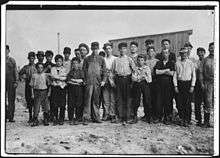
In 1930, Alexandria annexed the town of Potomac. That town, adjacent to Potomac Yard, had been laid out beginning in the late 19th century and incorporated in 1908.
Geography

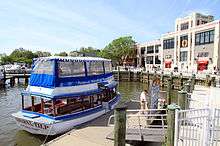
According to the United States Census Bureau, the city has a total area of 15.5 square miles (40.1 km2), of which 15.0 square miles (38.9 km2) is land and 0.42 square miles (1.1 km2), or 2.85%, is water.[19] Alexandria is bounded on the east by the Potomac River, on the north and northwest by Arlington County, and on the south by Fairfax County. The western portions of the city were annexed from those two entities beginning in the 1930s.
The addressing system in Alexandria is not uniform and reflects the consolidation of several originally separate communities into a single city. In Old Town Alexandria, building numbers are assigned north and south from King Street and west (only) from the Potomac River. In the areas formerly in the town of Potomac, such as Del Ray and St. Elmo, building numbers are assigned east and west from Commonwealth Avenue and north (only) from King Street. In the western parts of the city, building numbers are assigned north and south from Duke Street.
The ZIP code prefix 223 uniquely identifies the Alexandria postal area. However, the Alexandria postal area extends into Fairfax County and includes addresses outside of the city. Delivery areas have ZIP codes 22301, 22302, 22203, 22304, 22305, 22306, 22307, 22308, 22309, 22310, 22311, 22312, 22314, and 22315, with other ZIP codes in use for post office boxes and large mailers (22313, 22331, 22332, 22333).
Adjacent jurisdictions include:
- Arlington County, Virginia – north
- Fairfax County, Virginia – west and south
- District of Columbia – northeast
- Prince George's County, Maryland – east
There is one national protected area in Alexandria:
Climate
The climate in this area is characterized by hot, humid summers and generally mild to cool winters. According to the Köppen Climate Classification system, Alexandria has a humid subtropical climate, abbreviated "Cfa" on climate maps.[20]
Eco-City
In 2008, the Alexandria City Council approved an "Eco-City" charter with the goal of guiding the city and its residents toward "sustainability". The term "Eco-City" was first coined by Richard Register in his 1987 book Ecocity Berkeley: building cities for a healthy future. An "Eco-City" is typically defined as one in which inhabitants are dedicated to the moderate use of energy, water and food as well as minimizing pollution. Alexandria, however, defined sustainability instead as meeting the city's present needs while preserving its historic character and ensuring the ability of future generations to meet their own needs.
Neighborhoods
Neighborhoods in Alexandria include Old Town, Eisenhower Valley, Rosemont, The Berg, Parker-Gray, Del Ray, Arlandria, West End, and North Ridge.
Many neighborhoods and cities outside of the city limits, including Hollin Hills, Franconia, Groveton, Hybla Valley, Huntington, Belle Haven, Mount Vernon, Fort Hunt, Engleside, Burgundy Village, Waynewood, Wilton Woods, Rose Hill, Virginia Hills, Hayfield, and Kingstowne use an Alexandria address. These areas are actually part of Fairfax County, not the City of Alexandria. Many locals refer to the non-City-of-Alexandria area that has an Alexandria zip code as "Lower Alexandria" or "South Alexandria"; it may also sometimes be called "Alexandria, Fairfax County."[21]
Government
_City_Hall.jpg)
As an independent city of Virginia (as opposed to an incorporated town within a county), Alexandria derives its governing authority from the Virginia General Assembly. In order to revise the power and structure of the city government, the city must request the General Assembly to amend the charter. The present charter was granted in 1950 and it has been amended in 1968, 1971, 1976, and 1982.
Alexandria adopted a council-manager form of government by way of referendum in 1921. This type of government empowers the elected City Council to pass legislation and appoint the City Manager. The City Manager is responsible for overseeing the city's administration.
The Mayor, who is chosen on a separate ballot, presides over meetings of the Council and serves as the ceremonial head of government. The Mayor does not have the power to veto Council action. Council members traditionally choose the person receiving the most votes in the election to serve as Vice Mayor. In the absence or disability of the Mayor, the Vice Mayor performs the mayoral duties.
| Position | Name | Party | First Election | District | |
|---|---|---|---|---|---|
| Mayor | Allison Silberberg | Democratic Party | 2012 | At-Large | |
| Vice Mayor | Justin Wilson | Democratic Party | 2007 – 2009 2012 |
At-Large | |
| Member | John T. Chapman | Democratic Party | 2012 | At-Large | |
| Member | Timothy B. Lovain | Democratic Party | 2006 – 2009 2012 |
At-Large | |
| Member | Redella S. "Del" Pepper | Democratic Party | 1985 | At-Large | |
| Member | Paul C. Smedberg | Democratic Party | 2003 | At-Large | |
| Member | Willie Bailey | Democratic Party | 2015 | At-Large | |
In 2008, the City of Alexandria had 78 standing local boards, commissions, and committees to advise the City Council on major issues affecting the community.[23] All members are appointed by the City Council.
Alexandria is part of Virginia's 8th congressional district, represented by Democrat and Alexandria resident Don Beyer, elected in 2014.
The state's senior member of the United States Senate is Democrat Mark Warner, elected in 2008. The state's junior member of the United States Senate is Democrat Tim Kaine, elected in 2012.
The city operates a jail for pre-trial and short-term inmates. This jail is used to house pre-trial inmates in federal espionage cases.[24]
Demographics
| Historical population | |||
|---|---|---|---|
| Census | Pop. | %± | |
| 1790 | 2,748 | — | |
| 1800 | 4,971 | 80.9% | |
| 1810 | 7,227 | 45.4% | |
| 1820 | 8,218 | 13.7% | |
| 1830 | 8,241 | 0.3% | |
| 1840 | 8,459 | 2.6% | |
| 1850 | 8,734 | 3.3% | |
| 1860 | 12,652 | 44.9% | |
| 1870 | 13,570 | 7.3% | |
| 1880 | 13,659 | 0.7% | |
| 1890 | 14,339 | 5.0% | |
| 1900 | 14,528 | 1.3% | |
| 1910 | 15,329 | 5.5% | |
| 1920 | 18,060 | 17.8% | |
| 1930 | 24,149 | 33.7% | |
| 1940 | 33,523 | 38.8% | |
| 1950 | 61,787 | 84.3% | |
| 1960 | 91,023 | 47.3% | |
| 1970 | 110,927 | 21.9% | |
| 1980 | 103,217 | −7.0% | |
| 1990 | 111,183 | 7.7% | |
| 2000 | 128,283 | 15.4% | |
| 2010 | 139,966 | 9.1% | |
| Est. 2015 | 153,511 | [4] | 9.7% |
| U.S. Decennial Census[25] 1790–1960[26] 1900–1990[27] 1990–2000[28] 2013 Estimate | |||
At the 2010 census,[29] there were 139,966 people, 68,082 households and 30,978 families residing in the city. The population density was 8,452.0 per square mile (3,262.9/km²). There were 68,082 housing units at an average density of 4,233.2 per square mile (1,634.2/km²). The folks of the city were:
- 60.9% White
- 21.8% African American
- 6.0% Asian (1.3% Indian, 1.0% Filipino, 0.9% Chinese, 0.8% Korean, 0.5% Thai, 0.3% Vietnamese, 0.2% Japanese, 1.0% Other)
- 0.4% Native American
- 0.1% Pacific Islander
- 3.7% from two or more races
- 16.1% of the population were Hispanics or Latinos of any national origin (4.6% Salvadoran, 1.7% Mexican, 1.6% Honduran, 1.1% Guatemalan, 1.1% Puerto Rican, 0.9% Bolivian, 0.8% Peruvian, 0.4% Colombian)
In 2000, there were 61,889 households of which 18.6% had children under the age of 18 living with them, 32.2% were married couples living together, 9.2% had a female householder with no husband present, and 55.2% were non-families. 43.4% of all households were made up of individuals and 6.8% had someone living alone who was 65 years of age or older. The average household size was 2.04 and the average family size was 2.87.
The age distribution was 16.8% under the age of 18, 9.2% from 18 to 24, 43.5% from 25 to 44, 21.5% from 45 to 64, and 9.0% who were 65 years of age or older. The median age was 34 years. For every 100 females there were 93.5 males. For every 100 females age 18 and over, there were 91.7 males.
According to a 2007 estimate, the median household income was $80,806 and the median family income was $102,435.[30] Males had a median income of $47,514 versus $41,254 for females. The per capita income for the city was $37,645. 8.9% of the population and 6.8% of families were below the poverty line. 13.9% of those under the age of 18 and 9.0% of those 65 and older were living below the poverty line.
Economy
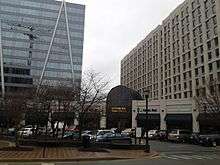
Companies headquartered in Alexandria include the Institute for Defense Analyses, VSE, and the Pentagon Federal Credit Union.
Alexandria is home to numerous trade associations, charities, and non-profit organizations including the national headquarters of groups such as the American Diabetes Association, BoatUS, Catholic Charities, Citizens for the Republic, Global Impact, Good360, Islamic Relief USA, United Way, Volunteers of America and the Salvation Army. Other organizations located in Alexandria include American Coalition for Clean Coal Electricity, the American Counseling Association, the Society for Human Resource Management, the National Society of Professional Engineers, the National Beer Wholesalers Association, and the International Centre for Missing & Exploited Children (ICMEC).
Largest employers
According to the City's 2015 Comprehensive Annual Financial Report,[31] the top public employers in the city, whose employees make up an estimated 14.84% of the total city employment, are:
| # | Employer | # of employees |
|---|---|---|
| 1 | United States Department of Commerce | 1,000+ |
| 2 | United States Department of Defense | 1,000+ |
| 3 | City of Alexandria | 2,547 |
| 4 | Alexandria City Public Schools | 2,268 |
| 5 | Washington Metropolitan Area Transit Authority | 500–999 |
| 6 | Northern Virginia Community College | 500–999 |
| 7 | United States Department of Agriculture | 500–999 |
The top private employers in the city, whose employees make up an estimated 7.24% of the total city employment, are:
| # | Employer | # of employees |
|---|---|---|
| 1 | Inova Health System | 1,000+ |
| 2 | ABM Janitorial Services | 500–999 |
| 3 | Institute for Defense Analyses | 500–999 |
| 4 | Grant Thornton LLP | 500–999 |
| 5 | CNA (left Alexandria in 2014) | 250–499 |
| 6 | Oblon | 250–499 |
| 7 | Roman Catholic Diocese of Arlington | 250–499 |
Education
Schools

The city is served by the Alexandria City Public Schools system and by the Alexandria campus of Northern Virginia Community College. The largest seminary in the Episcopal Church, Virginia Theological Seminary, is located on Seminary Road. Virginia Tech's Washington-Alexandria Architecture Center, also known as WAAC, is located on Prince Street in Old Town, offering graduate programs in Urban Affairs and Planning, Public and International Affairs, Architecture, and Landscape Architecture. Virginia Commonwealth University operates a Northern Virginia branch of its School of Social Work and The George Washington University (Washington DC) also has a campus near the King Street metro. This campus mainly offers professional and vocational programs, such as an executive MBA program, urban planning and security studies.
Alexandria has several of the Washington, D.C., area's top private schools, such as St. Stephen's and St. Agnes School, Bishop Ireton High School, and Episcopal High School. Also in the city are Alexandria Country Day School, Commonwealth Academy, St. Mary's Catholic School, St. Rita's Catholic School, Blessed Sacrament School and Global Health College.
Alexandria's public school system consists of thirteen elementary schools for grades 5-year-old Kindergarten through Grade 5. Middle Schools, George Washington and Francis C. Hammond, serve 6th through 8th graders. Minnie Howard Ninth Grade Center and T.C. Williams High School serve grades 9th and 10 through 12, respectively, for the entire city.
The demographics of Alexandria City Public Schools contrast with those of the city. In 2008, only 14% of the students at Francis C. Hammond Middle School were non-Hispanic whites, compared to about 60% when looking at the city as a whole. 27% were of Hispanic descent, and 48% were black. About 9% of the school was of Asian descent. In 2004, 62% of the schoolgoing children received free lunches; by 2008, that number had decreased to 56%.[32] At George Washington Middle School, 30% of students are non-Hispanic whites, 24% were Hispanic, and 41% was black; 3% of the students were Asian, and 52% of students received free lunch.[33] T.C. Williams High School follows this trend as well; 23% of the students were classified as non-Hispanic whites, 25% as Hispanic, and 44% as black. 7% of the school was Asian, and 47% of all students received free lunch.[34]
Public libraries
The Alexandria Library serves the residents of the City of Alexandria with four locations:
- Charles E. Beatley, Jr. Central Library (Main branch): 5005 Duke Street, Alexandria
- Kate Waller Barrett Branch: 717 Queen Street, Alexandria
- Ellen Coolidge Burke Branch: 4701 Seminary Road, Alexandria
- James M. Duncan Branch: 2501 Commonwealth Avenue, Alexandria
The library system provides a variety of services which include adult, young adult, and children's materials, as well as access to genealogy records and full text articles from thousands of magazines and newspapers through online databases. E-Books can be borrowed through OverDrive e-Audio books and all branches offer free public Internet access and free Wifi.[35]
The Alexandria Library maintains a reciprocal agreement with neighboring libraries in Arlington, District of Columbia, Fairfax, Falls Church, Fauquier, Frederick, Loudoun, Montgomery, Prince George's, and Prince William.[36]
History of libraries
John Wise, a local Alexandria businessman and hotel keeper, hosted a meeting in his home in 1789 to discuss the creation of a Society for the Promotion of Useful Knowledge. Members include Rev. James Muir, physician Elisha Cullen Dick, and George Washington's personal attorney Charles Lee. The Society did not last for long. However, on July 24, 1794, the founders of the Society once again met at Wise's home to establish a subscription library. During the first year, one hundred nineteen men joined the circulating library which was to be called the Library Company of Alexandria. Members agreed to pay an initiation fee and annual dues. The company was chartered as a corporation in 1798 in an act passed by the General Assembly of Virginia.
Druggist Edward Stabler was elected the first librarian and the library's first location is believed to have been housed in his apothecary shop. James Kennedy was elected the second librarian, and the library moved to his residence and place of business. Kennedy sold books from his personal collection to the Library Company. Those books and other bought from two local merchants formed the foundation of the subscription library. The first catalog of the library's collection was published in 1797. The collection grew over time, bolstered in part by the fact that some members paid their dues in books. Most members were initially men, although records exist showing some women were members as early as 1798. One noted female member in 1817 was Mary L.F. Custis, wife of George Washington Parke Custis.
The catalog published in 1801 indicated a collection of 452 books, mostly on history and travel. By 1815, there were 1,022 entries in the catalog, and the collection had added more biographies, fiction, and magazines. The library was housed in several locations over the ensuing years, including the New Market House next to the City Hall, the Lyceum Company building, and Peabody Hall, which was owned by the Alexandria School Board. Raising funds for the library was a continuing challenge. In 1853, a lecture series was created to raise money. Speakers included Professor Joseph Henry of the Smithsonian, Colonel Francis H. Smith of the Virginia Military Institute, and humorist George W. Bagby.
The arrival of the Civil War in 1861 took its toll on the library collection. Members were able to remove some of the collection prior to the library's occupation by Union troops. The library was used as a hospital and much of the library's collection was lost during this time. After the war, the building was sold to a private owner who planned to turn the building into a private residence and asked the library to remove what was left of the collection. Funds continued to be hard to come by and in 1879, the Library Company closed. The remainder of its collection was stored in Peabody Hall.
In 1897, a group of women in Alexandria formed the Alexandria Library Association. The leaders of the group were Virginia Corse, Mrs. William B. Smoot, and Virginia Burke. They petitioned the school board to open a subscription library in Peabody Hall, using the old books stored there. Permission was given and doors to the new subscription library opened on December 1, 1897. In 1902, the library moved to the first floor of a house in the 1300 block of Prince Street while negotiations were underway for a permanent move to the Confederate Hall, located at 806 Prince Street. In May 1903, the library moved to the Confederate Hall, now known as the Robert E. Lee Camp Hall Museum, where it stayed for 34 years.
In 1936, Dr. and Mrs. Robert South Barrett presented a proposal to the Library Association. They agreed to donate a building in memory of Dr. Barrett's mother, Kate Waller Barrett, if the city would commit to running it as a public library. The city agreed and the Society of Friends offered a 99-year lease on an old Quaker graveyard located on Queen Street. The old library was closed on March 1 for the books to be packed and moved to the new library, which opened to the public in August 1937. The Alexandria Library Association became the Alexandria Library Society.
In 1939, the Barrett library was the scene of possibly the nation's first sit-in demonstrations, as Samuel Tucker, a young law school graduate from the neighborhood, and several other African-American residents insisted on access to the racially segregated library where they had been banned. Tucker later became a prominent attorney in Richmond.[37][38]
In 1947, the Library Society was reconstituted and took the earlier historic name Alexandria Library Company. A lecture series was also revived. Speakers included Thomas Jefferson biographer Dumas Malone. Some of the books belonging in the original collection of the Alexandria Library Company can now be found in the Local History/Special Collections Room at the Queen Street library that still carries Mrs. Barrett's name.[39]
In 1948 Ellen Coolidge Burke became director. Burke brought bookmobile services to Alexandria, one of the first services in Virginia. She oversaw the growth of the library system by the addition of two new branch libraries. In April 1968 the Ellen Coolidge Burke Branch at 4701 Seminary Road was opened, and in December 1969 the James M. Duncan branch at 2501 Commonwealth Avenue. Burke retired in 1969.[40]
Points of interest
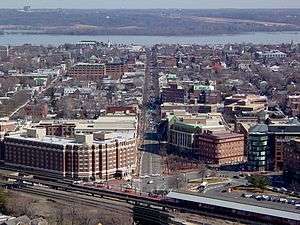
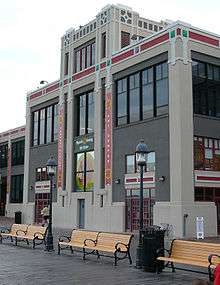
Landmarks
Landmarks within the city include the George Washington Masonic National Memorial (also known as the Masonic Temple) and Observation Deck, Christ Church, Gadsby's Tavern, John Carlyle House, Little Theatre of Alexandria, Lee-Fendall House, Alexandria City Hall, Market Square, the Jones Point Light, the south cornerstone of the original District of Columbia, Robert E. Lee's boyhood home, the Torpedo Factory Art Center, and the Virginia Theological Seminary. Other sites of historical interest in the city include Alexandria Black History Resource Center, Fort Ward Park and Museum, and the Alexandria Canal lock re-creation at Canal Office Center. Interesting sites with Alexandria addresses but outside of the city limits include River Farm, Collingwood Library & Museum, Green Spring Gardens Park, Huntley Meadows Park, Historic Huntley, Pope-Leighey House (designed by Frank Lloyd Wright), Woodlawn Plantation, Washington's Grist Mill and Mount Vernon Estate.
In 1830, John Hollensbury's home in Alexandria was one of two homes directly bordering an alleyway that received a large amount of horse-drawn wagon traffic and loiterers.[41] In order to prevent people from using the alleyway, Hollensbury constructed a 7 feet (2.1 m) wide, 25 feet (7.6 m) deep, 325-square-foot (30.2 m2), two story home using the existing brick walls of the adjacent homes for the sides of the new home.[41] The brick walls of the Hollensbury Spite House living room have gouges from wagon-wheel hubs; the house is still standing, and is occupied.[41]
Events
A popular Christmastime attraction in Alexandria is the Scottish Christmas Walk, which was established in 1969.[42] The event, which involves a parade through the center of Old Town Alexandria, celebrates the city's Scottish heritage, and is the centerpiece of a yearly holiday festival.[43] It serves as a fundraiser for social services in Alexandria.[42] Other parades in Old Town celebrate Saint Patrick's Day[44] and the birthday of George Washington.[45]
These parades and other official events are typically led by Alexandria's town crier, who, often dressed in elaborately, by a tradition dating to the 18th century, in a red coat, breeches, black boots and a tricorne hat, welcomes participants.[46]
Parks and recreation
Alexandria has a distributed park system with approximately 950 acres (3.8 km2) spread across 70 major parks and 30 recreation centers, of which Chinquapin is one of the largest. Chinquapin offers facilities for swimming, tennis, racquetball, and other sports. The city also organizes several sports leagues throughout the year including volleyball, softball and basketball.
The city is home to Cameron Run Regional Park which includes a water park with a wave pool and water slides, as well as a miniature golf course and batting cages. A portion of the Mount Vernon Trail, a popular bike and jogging path, runs through Old Town near the Potomac River on its way from the Mount Vernon Estate to Roosevelt Island in Washington, DC. There is also a largely unbroken line of parks stretching along the Alexandria waterfront from end to end.
Sports
Due to its proximity to Washington, Alexandria has only been the home of one professional sports team, the Alexandria Dukes, a minor league baseball team which has moved to Woodbridge and is now named the Potomac Nationals. However, the Cal Ripken Collegiate Baseball League brought baseball back to Alexandria in 2008 in the form of the Alexandria Aces. In addition, TC Williams, Bishop Ireton, St. Stephen's and Episcopal have storied histories in athletics, such as football, basketball, baseball and lacrosse. The largest youth sport in Alexandria is soccer with almost 2,500 players ages 2–18 who participate in the Alexandria Soccer Association.
Transportation
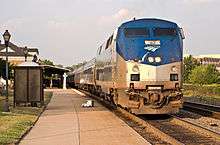
Alexandria is bisected east and west by State Route 7, known as King Street. The most western section of King St here once was the terminus of the Leesburg Turnpike. Interstate 95/495 (the Capital Beltway), including the Woodrow Wilson Bridge over the Potomac River, approximately parallels the city's southern boundary with Fairfax County. Interstate 395 crosses north and south through the western part of the city. Other major routes include north–south U.S. 1 (Patrick and Henry Streets after Patrick Henry, Jefferson Davis Highway and Richmond Highway), Washington St/George Washington Memorial Parkway, Russell Rd, Quaker Lane, Van Dorn St and Beauregard St, and east–west Duke Street (State Route 236), Braddock Rd and Janneys Lane/Seminary Rd.
Alexandria is south of, adjacent to Ronald Reagan Washington National Airport in Arlington County. Alexandria is also nearto Washington Dulles International Airport in Dulles, Virginia.
Alexandria Union Station, the city's historic train station, has Amtrak intercity services and the Virginia Railway Express regional rail service. The station is directly adjacent to the King Street – Old Town Washington Metro station, at the convergence of the Blue and Yellow Lines. Three other Metro stations in Alexandria are Braddock Road, Van Dorn Street, and Eisenhower Avenue.
The traditional boundary between Old Town and the latterly annexed sections of the city followed the railway now owned by CSX Transportation.
The city government operates its own mass transit system, the DASH bus, connecting points of interest with local transit hubs. Metrobus, Washington Metro, and the Virginia Railway Express, better known as the VRE, also serve Alexandria. The city also offers a free "trolley" diesel bus service on King Street from the King Street Metro Station to the Waterfront[47] and a water taxi to and from the National Harbor development in Prince George's County, Maryland.
Sister cities
Alexandria has four sister cities:[48]
Alexandria was twinned with Gyumri as a means of showing good will in the wake of the 1988 Armenian earthquake.[52]
Alexandria has been twinned with Caen in France since 1991. The sister city relationship sees delegations visiting between the two cities on a regular basis. Exchanges of students have been common. Musicians and choirs from the two cities have also made very successful visits. In most years, members of the Alexandria-Caen Sister City Committee travel to Caen for the Foire de Caen, a large international trade fair held in mid-September. Along with Caen's other sister cities, the Alexandria delegation has the chance to introduce its city to the people of Normandy, while getting the chance to learn more about this historic region of France.
The Office of Historic Alexandria in the Alexandria city government handles sister city projects.
Notable people
- Conor Mullee, New York Yankees pitcher.
- Eddie Royal, Chicago Bears wide receiver.
- Megan Young, Miss World Philippines 2013 and Miss World 2013.
- Thomas Kail, theater director.
- Diedrich Bader, actor
- Dean Muhtadi, former American football player and current WWE wrestler.
- Robert E. Lee, Civil War general, grew up on Oronoco Street
- Willard Scott, national television personality, grew up in Rosemont[53][54]
- Gerald R. Ford, former President of the United States, lived in Parkfairfax, and later on Crown View Drive
- Wernher von Braun, NASA rocket scientist[55]
- Richard M. Nixon, former President of the United States, lived in Parkfairfax.
In popular culture
- The Walking Dead comic book series and subsequent TV adaptation features a protected area of Alexandria known as the Safe Zone.
- Jim Morrison (from the band The Doors) graduated from George Washington High School in 1961.[56]
- The 2000 film Remember the Titans takes place in Alexandria and the cemetery scene was filmed at Ivy Hill Cemetery in Alexandria.
- The first scene of the 2006 film National Treasure: Book of Secrets was filmed at the George Washington Masonic Memorial.[57]
- Alternative rock band the Foo Fighters has a track titled "Arlandria" on their 2011 release Wasting Light; front man (and ex-Nirvana drummer) Dave Grohl lived in Alexandria during his childhood. The Arlandria neighborhood is also referenced in the song "Headwires" from the band's 1999 release, There Is Nothing Left to Lose.[58]
- The 100 character Lexa was named after Alexandria.[59]
- In The X-Files, the address of Special Agent Fox Mulder is given as Apartment 42, 2630 Hegal Place, Alexandria, VA 23242.[60]
See also
- List of famous people from the Washington, D.C. metropolitan area
- National Register of Historic Places listings in Alexandria, Virginia
- Alexandria Fire Department
References
Notes
- ↑ "American FactFinder". United States Census Bureau. Archived from the original on September 11, 2013. Retrieved January 31, 2008.
- ↑ "US Board on Geographic Names". United States Geological Survey. October 25, 2007. Retrieved January 31, 2008.
- ↑ "State & County QuickFacts". United States Census Bureau. Retrieved January 5, 2014.
- 1 2 "Annual Estimates of the Resident Population for Incorporated Places: April 1, 2010 to July 1, 2015". Retrieved July 2, 2016.
- ↑ "Economic Aspects of Tobacco during the Colonial Period 1612–1776". Tobacco.org. Retrieved January 29, 2012.
- ↑ "Discovering the Decades: 1740s | Historic Alexandria | City of Alexandria, VA". Alexandriava.gov. January 5, 2011. Retrieved January 29, 2012.
- ↑ "George Washington: Surveyor and Mapmaker". loc.gov.
- ↑ Journals of the House of Burgesses of Virginia, 1742–1747, 1748–1749 – Virginia. General Assembly. House of Burgesses, Virginia State Library – Google Books. Books.google.com. October 3, 2008. Retrieved January 29, 2012.
- ↑ The Scheme of a Lottery, at Belhaven, in Fairfax County: January 24, 1750/51; Virginia Gazette extracts; The William and Mary Quarterly, Vol.12 No.2 (October 1903)
- ↑ "Discovering the Decades: 1810s". Alexandria Archaeology Museum.
- ↑ "Self-Guided Walking Tour Black Historic Sites". Alexandria Black History Museum.
- ↑ Jim Barnett and H. Clark Burkett (2004). "The Forks of the Road Slave Market at Natchez". Mississippi History Now.
- ↑ "Photographs of African Americans During the Civil War: A List of Images in the Civil War Photograph Collection". Library of Congress. May 20, 2004.
- ↑ "Get to know D.C. – Frequently Asked Questions About Washington, D.C.". History Society of Washington, D.C.
- 1 2 "Death of Colonel Ellsworth, Harper's Weekly (June 15, 1861)". Sonofthesouth.net. January 26, 2007. Retrieved January 29, 2012.
- ↑ "Fort Ward Museum". Alexandriava.gov. Retrieved September 19, 2014.
- 1 2 "Office of Historic Alexandria, Alexandria Freedmen's Cemetery: Historical Overview, April 2007, p. 2." (PDF). Retrieved January 29, 2012.
- ↑
- ↑ "US Gazetteer files: 2010, 2000, and 1990". United States Census Bureau. February 12, 2011. Retrieved April 23, 2011.
- ↑ "Climate Summary for Alexandria, Virginia". Weatherbase. Retrieved September 19, 2014.
- ↑ "About homes and condos of Alexandria VA in Fairfax County". Nesbitt Realty.
- ↑ "Mayor & City Council". Alexandriava.gov. January 4, 2013. Retrieved January 24, 2016.
- ↑ "Roster of Alexandria Boards, Commissions and Committees". Alexandriava.gov. August 4, 2010. Retrieved January 29, 2012.
- ↑ Wise, David. "Mole-in-Training: How China Tried to Infiltrate the CIA." Washingtonian. June 7, 2012. Retrieved on August 6, 2016.
- ↑ "U.S. Decennial Census". United States Census Bureau. Archived from the original on May 11, 2015. Retrieved January 2, 2014.
- ↑ "Historical Census Browser". University of Virginia Library. Retrieved January 2, 2014.
- ↑ "Population of Counties by Decennial Census: 1900 to 1990". United States Census Bureau. Retrieved January 2, 2014.
- ↑ "Census 2000 PHC-T-4. Ranking Tables for Counties: 1990 and 2000" (PDF). United States Census Bureau. Retrieved January 2, 2014.
- ↑ "American FactFinder". United States Census Bureau. Archived from the original on September 11, 2013. Retrieved May 14, 2011.
- ↑ "Alexandria city, Virginia – Fact Sheet – American FactFinder". Factfinder.census.gov. Archived from the original on November 24, 2011. Retrieved January 29, 2012.
- ↑ City of Alexandria Virginia Comprehensive Annual Financial Report: Fiscal Year Ended June 30, 2015 Retrieved December 18, 2015
- ↑ "Best Places to Live in the United States". bestplaces.net.
- ↑ "Best Places to Live in the United States". bestplaces.net.
- ↑ "Best Places to Live in the United States". bestplaces.net.
- ↑ "Alexandria Library". Retrieved April 20, 2014.
- ↑ "Alexandria Library Get a Library Card". Retrieved April 20, 2014.
- ↑ "1939 Alexandria Library Sit-in". Jim Crow Lived Here. Retrieved 2016-11-27.
- ↑ "Alexandria Historical Society - Alexandria's History". Alexandriahistoricalsociety.wildapricot.org. Retrieved 2016-11-27.
- ↑ Seale, William. The Alexandria Library Company. Alexandria, Virginia: Alexandria Library, 2007.
- ↑ "Ellen Coolidge Burke". Alexandria Libraries.
- 1 2 3 Bailey, Steve. (February 29, 2008) The New York Times A Tiny, Beloved Home That Was Built for Spite. Section: F; Page F6. Location: 523 Queen St, Alexandria, VA 22314.
- 1 2 "Scottish Christmas Walk – St. Andrew's Society of Washington, D.C.". saintandrewsociety.org. Retrieved May 6, 2015.
- ↑ "Scottish Christmas Walk Weekend". campagnacenter.org. Retrieved May 6, 2015.
- ↑ Rachel Cooper. "2015 Alexandria Virginia Saint Patrick's Day Parade". About.com Travel. Retrieved May 6, 2015.
- ↑ "George Washington Birthday Celebration – Alexandria, VA". visitalexandriava.com. Retrieved May 6, 2015.
- ↑
- ↑ "DASH : King Street Trolley – FREE". dashbus.com. Retrieved February 12, 2015.
- ↑ "Code of Ordinances of the City of Alexandria, Virginia (Title 1, Chapter 2, Sec. 1-2-1)". City Council, City of Alexandria, Virginia. August 16, 2016. Retrieved September 5, 2016.
- ↑ "Tobacco to Tourism: Celebrating Alexandria's Scottish Heritage – "Dundee, Scotland: Alexandria's Sister City"". City Council, City of Alexandria, Virginia. Retrieved March 18, 2008.
- ↑ "National Commission for Decentralised cooperation". Délégation pour l'Action Extérieure des Collectivités Territoriales (Ministère des Affaires étrangères) (in French). Retrieved December 26, 2013.
- ↑ "Alexandria-Caen Sister City Committee website". Alexandria-Caen Sister City Committee. Retrieved September 19, 2014.
- ↑ "Alexandria–Gyumri Sister Cities Committee Report to the Alexandria City Council (March 2004)" (PDF). Alexandria–Gyumri Sister Cities Committee of the City of Alexandria, Virginia. March 2004. Retrieved September 5, 2016.
- ↑ Tennant, Thomas. "Willard Scott Biography | A brief snapshot of 'The Today Show' forecaster". Talkshows.about.com. Retrieved 2016-11-27.
- ↑ "Willard Scott Stroke | Search Net Worth of Celebrities". Searchnetworth.com. 1934-03-07. Retrieved 2016-11-27.
- ↑ "Space-Struck Resident". Connectionnewspapers.com. Retrieved 2016-11-27.
- ↑ "Jim Morrison Biography – Facts, Birthday, Life Story". Biography.com. Retrieved September 19, 2014.
- ↑ "Freemasonry, Eager to Step From Cultural Shadows". Washingtonpost.com. Retrieved September 19, 2014.
- ↑ Jackman, Tom (April 21, 2011). "Arlandria gets its own Foo Fighters song". The Washington Post.
- ↑ "Were Clarke and Lexa named after Clark Kent and Lex Luthor?". Kimshum.tumblr.com. Retrieved April 15, 2016.
- ↑ Cliff Bole (director); Vince Gilligan (writer) (April 20, 1997). "Small Potatoes". The X-Files. Season 4. Episode 20. Fox.
Further reading
 This article incorporates text from a publication now in the public domain: Chisholm, Hugh, ed. (1911). "Alexandria (Virginia)". Encyclopædia Britannica (11th ed.). Cambridge University Press.
This article incorporates text from a publication now in the public domain: Chisholm, Hugh, ed. (1911). "Alexandria (Virginia)". Encyclopædia Britannica (11th ed.). Cambridge University Press.- Powell, Mary G., The History of Old Alexandria Virginia, Richmond: William Byrd Press, 1928.
- Seale, William. The Alexandria Library Company, Alexandria, VA: Alexandria Library, 2007.
External links
| Wikimedia Commons has media related to Alexandria, Virginia. |
| Wikivoyage has a travel guide for Alexandria (Virginia). |
- City of Alexandria official website
- Official Alexandria visitors' website
- Alexandria Economic Development Partnership
- City of Alexandria at the Wayback Machine (archived April 13, 1997)
 |
Arlington County |  | ||
| Fairfax County | |
District of Columbia | ||
| ||||
| | ||||
| Fairfax County |




